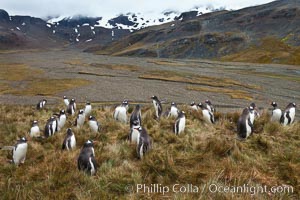
Gentoo penguins, permanent nesting colony in grassy hills about a mile inland from the ocean, near Stromness Bay, South Georgia Island.
Species: Gentoo penguin, Pygoscelis papua
Location: Stromness Harbour, South Georgia Island
Image ID: 24586
Species: Gentoo penguin, Pygoscelis papua
Location: Stromness Harbour, South Georgia Island
Image ID: 24586
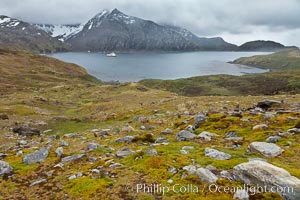
View of Godthul, from the grassy slopes of South Georgia. The name Godthul, or "Good Hollow", dates back to Norwegian whalers who used this bay as a anchorage.
Location: Godthul, South Georgia Island
Image ID: 24689
Location: Godthul, South Georgia Island
Image ID: 24689
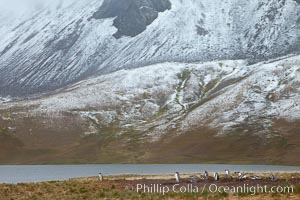
Gentoo penguins nesting beside a lake, snow-covered South Georgia mountains in the background.
Species: Gentoo penguin, Pygoscelis papua
Location: Godthul, South Georgia Island
Image ID: 24691
Species: Gentoo penguin, Pygoscelis papua
Location: Godthul, South Georgia Island
Image ID: 24691
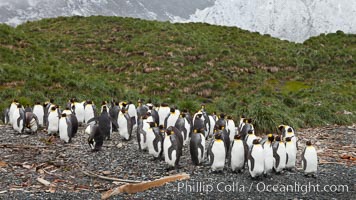
King penguins and whale bones, on the cobblestone beach at Godthul, South Georgia Island. The whale bones are evidence of South Georgia's long and prolific history of whaling.
Species: King penguin, Aptenodytes patagonicus
Location: Godthul, South Georgia Island
Image ID: 24692
Species: King penguin, Aptenodytes patagonicus
Location: Godthul, South Georgia Island
Image ID: 24692
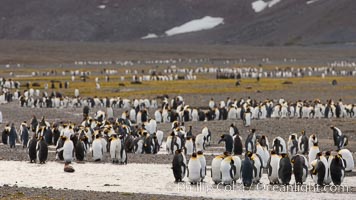
King penguin colony, Right Whale Bay, South Georgia Island. Over 100,000 pairs of king penguins nest on South Georgia Island each summer.
Species: King penguin, Aptenodytes patagonicus
Location: Right Whale Bay, South Georgia Island
Image ID: 24316
Species: King penguin, Aptenodytes patagonicus
Location: Right Whale Bay, South Georgia Island
Image ID: 24316
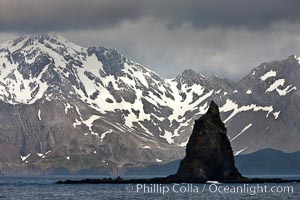
South Georgia Island coastline, showing the island's characteristic rugged topography. 56% of the island is covered by 161 glaciers, which have created numerous large bays and inlets that provide excellent habitat for marine animals and seabirds. Mountains meet the sea in steep-sided seacliffs covered with sparse vegetation. The highest point on South Georgia Island is Mt. Paget at 2,915m.
Location: South Georgia Island
Image ID: 24321
Location: South Georgia Island
Image ID: 24321
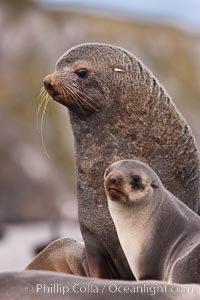
Antarctic fur seals, adult male bull and female, illustrating extreme sexual dimorphism common among pinnipeds (seals, sea lions and fur seals).
Species: Antarctic fur seal, Arctocephalus gazella
Location: Right Whale Bay, South Georgia Island
Image ID: 24324
Species: Antarctic fur seal, Arctocephalus gazella
Location: Right Whale Bay, South Georgia Island
Image ID: 24324
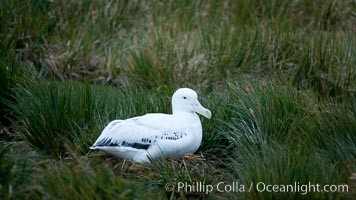
Wandering albatross, on nest in the Prion Island colony. The wandering albatross has the largest wingspan of any living bird, with the wingspan between, up to 12' from wingtip to wingtip. It can soar on the open ocean for hours at a time, riding the updrafts from individual swells, with a glide ratio of 22 units of distance for every unit of drop. The wandering albatross can live up to 23 years. They hunt at night on the open ocean for cephalopods, small fish, and crustaceans. The survival of the species is at risk due to mortality from long-line fishing gear.
Species: Wandering albatross, Diomedea exulans
Location: Prion Island, South Georgia Island
Image ID: 24394
Species: Wandering albatross, Diomedea exulans
Location: Prion Island, South Georgia Island
Image ID: 24394
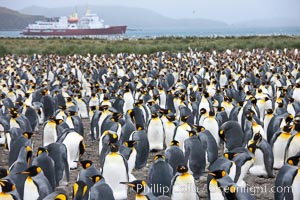
Icebreaker M/V Polar Star anchored in the Bay of Isles,offshore of the vast king penguin colony at Salisbury Plain.
Species: King penguin, Aptenodytes patagonicus
Location: Salisbury Plain, South Georgia Island
Image ID: 24397
Species: King penguin, Aptenodytes patagonicus
Location: Salisbury Plain, South Georgia Island
Image ID: 24397
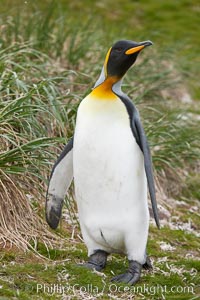
King penguin at Salisbury Plain, Bay of Isles, South Georgia Island.
Species: King penguin, Aptenodytes patagonicus
Location: Salisbury Plain, South Georgia Island
Image ID: 24398
Species: King penguin, Aptenodytes patagonicus
Location: Salisbury Plain, South Georgia Island
Image ID: 24398
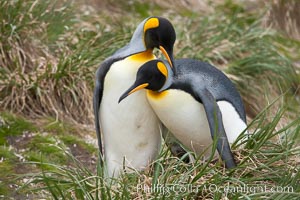
King penguin, mated pair courting, displaying courtship behavior including mutual preening.
Species: King penguin, Aptenodytes patagonicus
Location: Salisbury Plain, South Georgia Island
Image ID: 24399
Species: King penguin, Aptenodytes patagonicus
Location: Salisbury Plain, South Georgia Island
Image ID: 24399
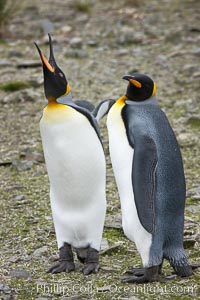
King penguin, mated pair courting, displaying courtship behavior.
Species: King penguin, Aptenodytes patagonicus
Location: Salisbury Plain, South Georgia Island
Image ID: 24400
Species: King penguin, Aptenodytes patagonicus
Location: Salisbury Plain, South Georgia Island
Image ID: 24400
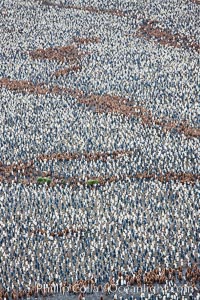
King penguin colony, over 100,000 nesting pairs, viewed from above. The brown patches are groups of 'oakum boys', juveniles in distinctive brown plumage. Salisbury Plain, Bay of Isles, South Georgia Island.
Species: King penguin, Aptenodytes patagonicus
Location: Salisbury Plain, South Georgia Island
Image ID: 24404
Species: King penguin, Aptenodytes patagonicus
Location: Salisbury Plain, South Georgia Island
Image ID: 24404
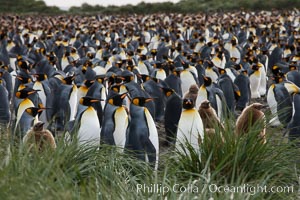
King penguin colony. Over 100,000 pairs of king penguins nest at Salisbury Plain, laying eggs in December and February, then alternating roles between foraging for food and caring for the egg or chick.
Species: King penguin, Aptenodytes patagonicus
Location: Salisbury Plain, South Georgia Island
Image ID: 24407
Species: King penguin, Aptenodytes patagonicus
Location: Salisbury Plain, South Georgia Island
Image ID: 24407
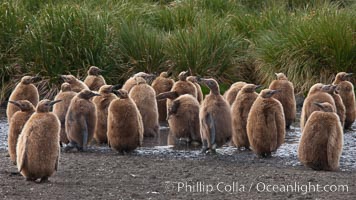
Oakum boys, juvenile king penguins at Salisbury Plain, South Georgia Island. Named 'oakum boys' by sailors for the resemblance of their brown fluffy plumage to the color of oakum used to caulk timbers on sailing ships, these year-old penguins will soon shed their fluffy brown plumage and adopt the colors of an adult.
Species: King penguin, Aptenodytes patagonicus
Location: Salisbury Plain, South Georgia Island
Image ID: 24408
Species: King penguin, Aptenodytes patagonicus
Location: Salisbury Plain, South Georgia Island
Image ID: 24408
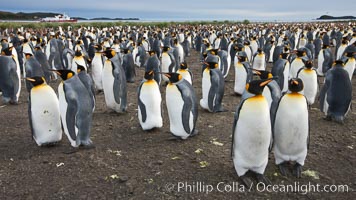
King penguin colony. Over 100,000 pairs of king penguins nest at Salisbury Plain, laying eggs in December and February, then alternating roles between foraging for food and caring for the egg or chick.
Species: King penguin, Aptenodytes patagonicus
Location: Salisbury Plain, South Georgia Island
Image ID: 24409
Species: King penguin, Aptenodytes patagonicus
Location: Salisbury Plain, South Georgia Island
Image ID: 24409
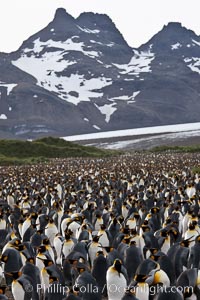
King penguin colony at Salisbury Plain, Bay of Isles, South Georgia Island. Over 100,000 pairs of king penguins nest here, laying eggs in December and February, then alternating roles between foraging for food and caring for the egg or chick.
Species: King penguin, Aptenodytes patagonicus
Location: Salisbury Plain, South Georgia Island
Image ID: 24410
Species: King penguin, Aptenodytes patagonicus
Location: Salisbury Plain, South Georgia Island
Image ID: 24410
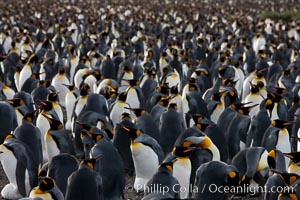
King penguin colony at Salisbury Plain, Bay of Isles, South Georgia Island. Over 100,000 pairs of king penguins nest here, laying eggs in December and February, then alternating roles between foraging for food and caring for the egg or chick.
Species: King penguin, Aptenodytes patagonicus
Location: Salisbury Plain, South Georgia Island
Image ID: 24411
Species: King penguin, Aptenodytes patagonicus
Location: Salisbury Plain, South Georgia Island
Image ID: 24411
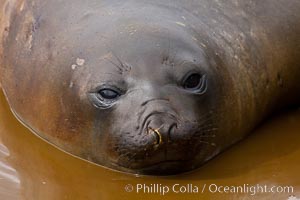
Southern elephant seal, juvenile. The southern elephant seal is the largest pinniped, and the largest member of order Carnivora, ever to have existed. It gets its name from the large proboscis (nose) it has when it has grown to adulthood.
Species: Southern elephant seal, Mirounga leonina
Location: Hercules Bay, South Georgia Island
Image ID: 24420
Species: Southern elephant seal, Mirounga leonina
Location: Hercules Bay, South Georgia Island
Image ID: 24420
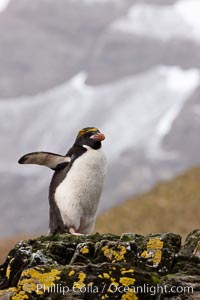
Macaroni penguin, on the rocky shoreline of Hercules Bay, South Georgia Island. One of the crested penguin species, the macaroni penguin bears a distinctive yellow crest on its head. They grow to be about 12 lb and 28" high. Macaroni penguins eat primarily krill and other crustaceans, small fishes and cephalopods.
Species: Macaroni penguin, Eudyptes chrysolophus
Location: Hercules Bay, South Georgia Island
Image ID: 24421
Species: Macaroni penguin, Eudyptes chrysolophus
Location: Hercules Bay, South Georgia Island
Image ID: 24421
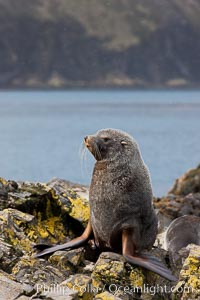
Antarctic fur seal, adult male (bull).
Species: Antarctic fur seal, Arctocephalus gazella
Location: Hercules Bay, South Georgia Island
Image ID: 24422
Species: Antarctic fur seal, Arctocephalus gazella
Location: Hercules Bay, South Georgia Island
Image ID: 24422
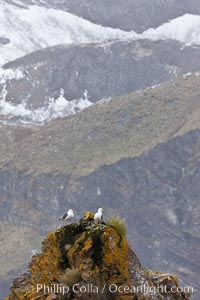
Sea gulls on rocks with mountains in the distance.
Location: Hercules Bay, South Georgia Island
Image ID: 24423
Location: Hercules Bay, South Georgia Island
Image ID: 24423
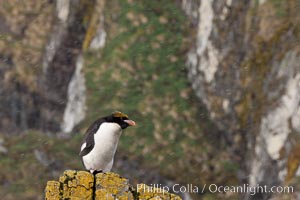
Macaroni penguin, on the rocky shoreline of Hercules Bay, South Georgia Island. One of the crested penguin species, the macaroni penguin bears a distinctive yellow crest on its head. They grow to be about 12 lb and 28" high. Macaroni penguins eat primarily krill and other crustaceans, small fishes and cephalopods.
Species: Macaroni penguin, Eudyptes chrysolophus
Location: Hercules Bay, South Georgia Island
Image ID: 24424
Species: Macaroni penguin, Eudyptes chrysolophus
Location: Hercules Bay, South Georgia Island
Image ID: 24424
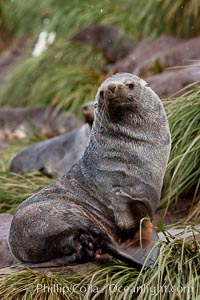
Antarctic fur seal, adult male (bull).
Species: Antarctic fur seal, Arctocephalus gazella
Location: Hercules Bay, South Georgia Island
Image ID: 24425
Species: Antarctic fur seal, Arctocephalus gazella
Location: Hercules Bay, South Georgia Island
Image ID: 24425
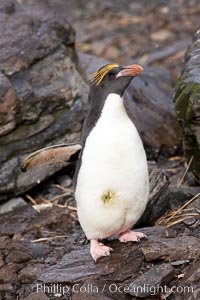
Macaroni penguin, on the rocky shoreline of Hercules Bay, South Georgia Island. One of the crested penguin species, the macaroni penguin bears a distinctive yellow crest on its head. They grow to be about 12 lb and 28" high. Macaroni penguins eat primarily krill and other crustaceans, small fishes and cephalopods.
Species: Macaroni penguin, Eudyptes chrysolophus
Location: Hercules Bay, South Georgia Island
Image ID: 24426
Species: Macaroni penguin, Eudyptes chrysolophus
Location: Hercules Bay, South Georgia Island
Image ID: 24426
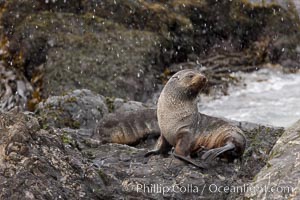
Antarctic fur seal, snowing, on rocky shoreline.
Species: Antarctic fur seal, Arctocephalus gazella
Location: Hercules Bay, South Georgia Island
Image ID: 24427
Species: Antarctic fur seal, Arctocephalus gazella
Location: Hercules Bay, South Georgia Island
Image ID: 24427
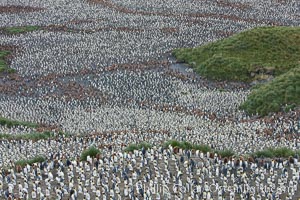
King penguin colony, over 100,000 nesting pairs, viewed from above. The brown patches are groups of 'oakum boys', juveniles in distinctive brown plumage. Salisbury Plain, Bay of Isles, South Georgia Island.
Species: King penguin, Aptenodytes patagonicus
Location: Salisbury Plain, South Georgia Island
Image ID: 24447
Species: King penguin, Aptenodytes patagonicus
Location: Salisbury Plain, South Georgia Island
Image ID: 24447
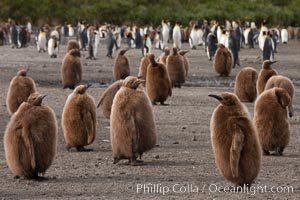
Oakum boys, juvenile king penguins at Salisbury Plain, South Georgia Island. Named 'oakum boys' by sailors for the resemblance of their brown fluffy plumage to the color of oakum used to caulk timbers on sailing ships, these year-old penguins will soon shed their fluffy brown plumage and adopt the colors of an adult.
Species: King penguin, Aptenodytes patagonicus
Location: Salisbury Plain, South Georgia Island
Image ID: 24455
Species: King penguin, Aptenodytes patagonicus
Location: Salisbury Plain, South Georgia Island
Image ID: 24455
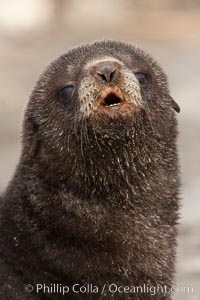
Antarctic fur seal, young pup, juvenile.
Species: Antarctic fur seal, Arctocephalus gazella
Location: Fortuna Bay, South Georgia Island
Image ID: 24597
Species: Antarctic fur seal, Arctocephalus gazella
Location: Fortuna Bay, South Georgia Island
Image ID: 24597
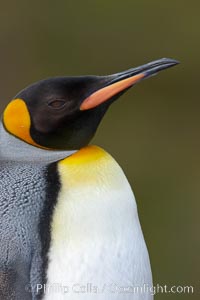
King penguin, showing ornate and distinctive neck, breast and head plumage and orange beak.
Species: King penguin, Aptenodytes patagonicus
Location: Fortuna Bay, South Georgia Island
Image ID: 24599
Species: King penguin, Aptenodytes patagonicus
Location: Fortuna Bay, South Georgia Island
Image ID: 24599